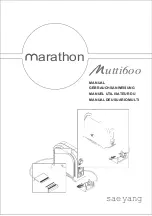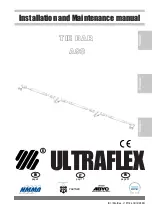
Carefully read the following application notes and adhere
to them. This product has been specifically designed for
working at a height or depth, but does not free the per-
sonnel from the personal risk involved.
Prior to initial use the user must familiarise himself with
the function of the device in a safe environment. Before
using the device, the user has to acquire information
concerning the possibilities for safe and effective rescue
action.
Concerning application of this product, we urgently re-
commend to observe any additional national regulations.
The user should be aware that unsuitable bodily or psy-
chological condition may compromise safety in both
normal operation and emergency situations.
The manufacturer does not bear any liability for misuse
and/or improper use. The responsibility and the risk is
borne in each and every case by the users or responsible
persons. Concerning application of this product, we ur-
gently recommend to observe any additional national
regulations. PPE products must be used exclusively to
safeguard persons.
Attention: Failure to observe these instructions may re-
sult in fatal accidents!
PRODUCT SPECIFIC NOTES:
Definition:
Fig. 1: Rope types to be used
Exclusively dynamic single ropes according to EN 892
must be used. Diameter range 8.9-11.0 mm (see Fig. 1a)
The actual rope diameter may differ by ± 0.2 mm from
the rated diameter indicated by the manufacturer. Use of
static ropes is allowed only for belaying with rope deflec-
tion (top roping) or for lowering or abseiling a person, but
not for securing of a lead climber! The OHM is NOT a
belay device! Avoid sagging of ropes.
Minimum breaking force of OHM: 15 kN (see Fig. 1a)
Weight difference: The unit is suitable for rope parties, in
which the lead climber is min. 10 kg and max. 40 kg
heavier than the person belaying him. Persons weighing
less than 40 kg must not use the device. (see Fig. 1b)
Fig. 2: Preparing the OHM
Using an express sling with a total length of min. 20 cm
to max. 30 cm, install the OHM to the first protection
point of a securing line. The correct feed direction of the
rope corresponds to the pictorials on the device and
must be checked before every use. (see Fig. 2)
Fig. 3: Rest position
The OHM is suspended with no load from the first pro-
tection point. (see Fig. 3b)
Activated condition: Upon a fall or during tensile loading,
the OHM is pulled up and ads friction into the breaking
process. (see Fig. 3a)
Fig. 4: Installation
The OHM is attached to the first protection point of a
securing line. The person belaying must be located at a
distance of at least 1 m in each direction outside the fall
line of the first intermediate protection point (similar to
the recommendations of DAV and KleVer). (see Fig. 4a) If
the wall is inclined less than 90°, the lateral distance to
the fall line must be at least 1 m, to ensure OHM is func-
tioning properly. (see Fig. 4b) To secure a top rope clim-
ber, the OHM is likewise installed in the first intermediate
protection point. (see Fig. 4c)
If the belayer is vertically below the hinge point of OHM, the
unit‘s brake function may not work properly. (see Fig. 4d)
Attention: The OHM must always be installed at the first
protection point used. If the OHM is used at the second
or even a higher intermediate protection point, it will not
brake the rope at all (see Fig. 4e).
On a roof edge, ensure that the OHM has enough space
to be activated, as the braking function may otherwise
not work properly. (see Fig. 4f)
The OHM may be attached exclusively to rock anchor
straps, adhesive anchors and rings. Use of mobile pro-
tection is not allowed. (see Fig. 4g)
Fig. 5: Loosening the unit
If the unit has been activated unintentionally or if it is to
be restored to the rest position upon relieving the tensi-
on on the rope, it is enough to shake the rope. If no load
is acting on the climbing rope, the OHM will then drop
back from the activated position to the rest position.
Fig. 6: Correct insertion of rope
The unit must be opened to insert the rope. Do so by
opening the snap lock and then turning the side plate.
Summary of Contents for 720700001380
Page 1: ...OHM...
Page 2: ...1a 8 9 11 0 mm 15 kN EN 892...
Page 4: ...2a 2b min 20 cm max 30 cm 3a 3b...
Page 5: ...1 m 90 1 m 1 m 4a 4b...
Page 6: ...1 m 1 m 4c 4d...
Page 7: ...4e 4f...
Page 8: ...4g Bohrhaken Schlaghaken...
Page 9: ...5...
Page 10: ...6a 6b 6c...
Page 11: ...6f 6e 6g 6d...
Page 12: ...7a 7c 7b...
Page 13: ...8...
Page 14: ...9...
Page 15: ...10 11...
Page 78: ...CE PPE 30 C 60 C 10 1 2 1 10 PPE 10 C 30 C...
Page 79: ...EDELRID mm PPE 1 YYYY MM 0123 PPE EDELRID GmbH Co KG EU 2016 425 http www edelrid de JAP...
Page 82: ...30 60 C 10 1 2 1 1 10 PPE 10 30 C EDELRID mm YYYY MM 4 2 0123 PPE EU...
Page 86: ......
Page 87: ......
















































